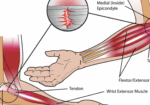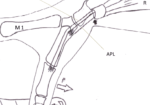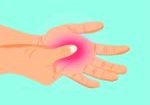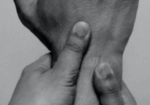Piacenza A, Vittonetto D, Rossello MI, Testa M. Arthrodesis Versus Arthroplasty in Thumb Carpometacarpal Osteoarthritis: Impact on Maximal Voluntary Force, Endurance, and Accuracy of Pinch. J Hand Surg Am. 2021 May 24:S0363-5023(21)00199-4. doi: 10.1016/j.jhsa.2021.03.023. Epub ahead of print. PMID: 34045112.
The Skinny:
This was a retrospective study based on a convenience sample of individuals who had thumb surgery for 1stcarpal metacarpal (CMC) osteoarthritis (OA – thumb CMC arthroplasty) between 2011 and 2018.
These researchers set out to compare post-treatment strength recovery of individuals who had either had arthrodesis or suspension arthroplasty surgeries to address their OA.
Thumb Arthrodesis and suspension arthroplasty are the two most common surgical approaches for this diagnosis, but it is undetermined whether one is more beneficial than the other for long-term outcomes.
The Arthrodesis: Articular surfaces were removed using a saw, and the joint is fused into a functional position with a memory staple.
The Thumb Suspension Arthroplasty: A trapeziectomy (removal of trapezium) was performed through a dorsal incision in the thumb, and then APL was sutured to FCR
In the Weeds:
A total of 37-subjects between the ages of 40 and 70-years of age (and their CMC arthroplasty reviews) were included in this study. Data was collected after one year preceding thumb surgery of either arthrodesis or suspension arthroplasty. The same surgeon made surgical decisions and procedures for all individuals.
Exclusion criteria: Individuals were excluded if they had concurrent wrist/hand pathologies such as carpal tunnel, de Quervain’s, gout, rheumatoid arthritis, scleroderma, and/or CRPS. Individuals were also excluded if they’d had an ‘acute inflammatory state’ in the CMC joint the week before the assessment.
Of the initial 227 individuals considered for this study, only 37 ended up participating.
All measurements were taken using a haptic device that provided visual feedback based on force.
Maximal voluntary contraction (MVC) was measured by having individuals pinch the device as hard as they could, using a pulp-to-pulp pinch, two times.
The dynamic force was measured with 10-repetitions of ‘pinching’ with a target of 70% accuracy. Individuals were tasked with administering different amounts of force to ‘hit’ the targets provided using the digital device.
Endurance was measured as a sustained 10-second pinch with a consistent target of 30% strength.
Precision was also measured using the mean distance and offset error from each target. And standard deviations were used to determine strength steadiness.
It should be noted that the arthrodesis group included: a lower percentage of dominant hands (40% vs. 50%), a longer time interval since their surgeries, and more males than the suspension arthroplasty groups (36.4% vs. 20%).
Among the arthrodesis group, the MVC was significantly higher. However, there were no significant differences in endurance or precision between groups.
With that being said, the standard deviations were more consistent for the arthrodesis group, and the arthroplasty group had a more significant fatigue trend based on the dynamic force measurement.
Previous studies haven’t found significant differences between pulp-to-pulp pinch strength preceding arthroplasty vs. arthrodesis. However, this study was unique in that it used a visual feedback device rather than a dynamometer, and only tip-to-tip pinch results were measured.
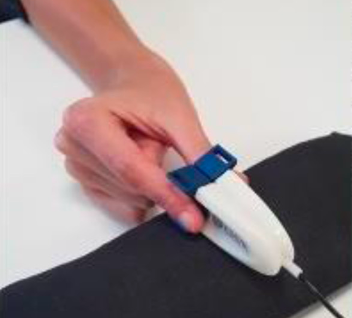
Bring it Home:
This study concludes that arthrodesis surgery may lead to an increased MVC in terms of strength recovery. However, in this study, the arthrodesis group also included 10% more males, which may have slightly skewed those results. These researchers also stake the claim that based on standard deviations alone, the arthroplasty group may have more post-op ‘strength steadiness.’ Also, the arthroplasty group had a higher fatigue trend.
Also: Less than 20% of the initial eligible participants were included in this study, which is not a great statistic. It is understood that researchers would exclude other diagnoses of the hand/wrist. But was it best to exclude those who had swelling or pain in their thumbs the week prior? It seems as though those results may have been beneficial for the research.
Also, there are no norms set for tip-to-tip pinch, which meant that measures couldn’t be compared to the non-affected population. Furthermore, since OA is typically bilateral in nature, it was not feasible to compare the ‘affected’ and ‘non-affected’ hands of each participant.
Rating: 3/5 This study shows good implications for arthrodesis over arthroplasty. But with such a small sample size and no consistent differences for most measures, this study does not necessarily answer the question that it set out to address. More research is necessary to determine the most effective surgical technique for 1st CMC joint arthritis.
More To Read
Tennis Elbow and Graded Exercises
Lateral Elbow Pain with Graded Exercise Chronic tennis elbow with a supervised graded exercise protocol Özdinçler, A. R., Baktır, Z. S., Mutlu, E. K., & Koçyiğit, A. (2023). Chronic lateral elbow tendinopathy with a supervised graded exercise protocol. Journal of Hand Therapy, 36(4), 913–922. https://doi.org/10.1016/j.jht.2022.11.005 The Skinny: This study looked at the effectiveness of an…
Read MoreA Better De Quervain’s Tenosynovitis Test
J. F. Goubau, L. Goubau, A. Van Tongel, P. Van Hoonacker, D. Kerckhove, B. Berghs (2013).The wrist hyperflexion and abduction of the thumb (WHAT) test: a more specific and sensitive test to diagnose de Quervain tenosynovitis than the Eichhoff’s Test. J Hand Surg Eur Vol. 2014 Mar; 39(3): 286–292. Published online 2013 Jan 22. doi:…
Read MoreHow much pain should a patient have during and after therapy?
How much pain should a patient have during and after therapy? As we all know pain is somewhat subjective. It can be hard to determine how much pain a patient should experience with the type of injury as well as the type of therapy intervention and hand pain treatment. The saying of “no pain, no…
Read MoreTest for Distal Radial Ulnar Joint of the Wrist
Ballottment Test for Wrist DRUJ Reliability and Validity Analysis of the Distal Radioulnar Joint Ballottement Test Nagashima, M., Omokawa, S., Hasegawa, H., Nakanishi, Y., Kawamura, K., & Tanaka, Y. (2024). Reliability and validity analysis of the distal radioulnar joint ballottement test. The Journal of Hand Surgery, 49(1), 15–22. https://doi.org/10.1016/j.jhsa.2023.10.006 The Skinny: Distal radioulnar joint (DRUJ)…
Read MoreSign-up to Get Updates Straight to Your Inbox!
Sign up with us and we will send you regular blog posts on everything hand therapy, notices every time we upload new videos and tutorials, along with handout, protocols, and other useful information.


